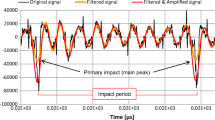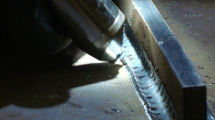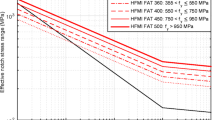Abstract
Post-treatment techniques like the high frequency mechanical impact treatment (HFMI) exhibit a significant fatigue life enhancement of welded joints. The effectiveness of this mechanical impact treatment is primarily based on the combination of three effects: the local hardness increase, compressive residual stresses and reduced notch stress concentration at the weld toe. The goal of the present study was to develop a computationally efficient approach for predicting residual stresses induced by the HFMI process on steel specimens. For that purpose, explicit simulations of this post weld treatment technique were performed utilizing the software package ABAQUS. Although, the focus of this study is to find suitable process and material parameters as input for the numerical simulation. For this, the impact velocity, contact force and permanent indentation depth of a pneumatic HFMI-tool were measured. Concerning material modelling, an enhanced combined material model with strain rate dependency was applied. Furthermore, the simulated residual stress field was experimentally validated by X-ray diffraction and neutron diffraction residual stress measurement. The results of the simulations are in good agreement with the experimental results, showing that the material hardening model used for simulation has a high influence on the calculated residual stress values.







Similar content being viewed by others
References
Statnikov E, Trufyakov V, Mikheev P, Kudryavtsev Y (1996) Specification for weld toe improvement by ultrasonic impact treatment. International Institute of Welding, Paris [IIW Document XIII-1617-96]
Yildirim HC, Marquis GB, Barsoum Z (2013) Fatigue assessment of high frequency mechanical impact (HFMI)-improved fillet welds by local approaches. Int J Fatigue 52:57–67
Yildirim HC, Marquis GB (2012) Fatigue strength improvement factors for high strength steel welded joints treated by high frequency mechanical impact. Int J Fatigue 44:168–176
Marquis GB, Mikkola E, Yildirim HC, Barsoum Z (2013) Fatigue strength improvement of steel structures by high-frequency mechanical impact: proposed fatigue assessment guidelines. Weld World 57:803–822
Marquis G, Barsoum Z (2013) Fatigue strength improvement of steel structures by high-frequency mechanical impact: proposed procedures and quality assurance guidelines. Weld World. doi:10.1007/s40194-013-0077-8
Yildirim HC, Marquis GB (2014) Fatigue design of axially-loaded high frequency mechanical impact treated welds by the effective notch stress method. Mater Des 58:543–550
Haagensen PJ, Maddox SJ. IIW Recommendations on post weld improvement of steel and aluminum structures, IIW Document XIII-2200r4-07, revised February 2010
Nüsse G (2011) REFRESH Lebensdauerverlängerung bestehender und neuer geschweißter Stahlkonstruktionen (in German)., Verlags und Vertriebsgesselschaft Forschungsvereinigung Stahlanwendungen
Le Quilliec G, Lieurade H-P, Bousseau M, Drissi-Habti M, Inglebert G, Maxquet P, Jubin L (2011) Fatigue behavior of Welded Joints Treated by High Frequency Hammer Peening: Part I, Experimental study, IIW Document XIII-2394-11
Tehrani Yekta R, Ghahremani K (2013) Scott Walbridge: effect of quality control parameter variations on the fatigue performance of ultrasonic impact treated welds. Int J Fatigue 55:245–256
Berg J, Stranghoener N (2014) Fatigue strength of welded ultra high strength steels improved by high frequency hammer peening. Proc Mater Sci 3:71–76
Leitner M, Gerstbrein S, Ottersböck MJ, Stoschka M (2015) Fatigue strength of HFMI-treated high-strength steel joints under constant and variable amplitude block loading. Proc Eng 101:251–258
Mikkola PE, Marquis G. Material characterization of high-frequency mechanical impact treated high-strength steel. IIW document XIII-2528-14
Lefebvre F, Revilla-Gomez C, Buffiere J-Y, Verdu C, Peyrac C (2014) Understanding the mechanism responsible for the beneficial effect of hammer peening in welded structure under fatigue loading. Adv Mater Res 996:761–768
Le Quilliec G, Lieurade H-P, Bousseau M, Drissi-Habti M, Inglebert G, Macquet P, Jubin L. Fatigue Behavior of Welded Joints Treated by High Frequency Hammer Peening: Part II, Numerical Study, IIW Document XIII-2395-11
Baptistaa R, Infante V, Branco C (2011) Fully dynamic numerical simulation of the hammer peening fatigue life improvement technique. Proc Eng 10:1943–1948
Simunek D, Leitner M, Stoschka M. Numerical simulation loop to investigate the local fatigue behaviour of welded and HFMI-treated joints, IIW Document XIII-WG2-136-13
Guo C, Wang Z, Wang D, Hu S (2015) Numerical analysis of the residual stress in untrasonic impact treatment process single-impact and two impact-models. Appl Surf Sci 347:596–601
Abaqus 6.13 (2013) Analysis User’s Manual. Simulia, Dassault Systémes
Chaboche J-L (2008) A review of some plasticity and viscoplasticity constitutive theories. Int J Plast 24:1642–1693
Muransky ‘O, Hamelin C, Smith M, Bendeich P, Edwards L (2012) The effect of plasticity theory on predicted residual stress fields in numerical weld analyses. Comput Mater Sci 54:125–134
Chaboche JL (1993) Cyclic viscoplastic constitutive equations, Part I: a thermodynamically consistent formulation, J. Appl. Mech. 60, 1993, pp. 813–821. Part II: stored energy—comparison between models and experiments. J Appl Mech 60:822–828
Chaboche JL (1977) Viscoplastic constitutive equations for the description of cyclic and anisotropic behaviour of metals. Bol Acad Sci Sér Sci Tech XXV(1):33
Lemaite J, Chaboche J (1994) Mechanics if solid materials, Cambridge university press
Harati, Ebrahim et al. (2014) Non-destructive measurement of weld toe radius using Weld Impression Analysis, Laser Scanning Profiling and Structured Light Projection methods. First International Conference on Welding and Non Destructive Testing, Tehran, Iran
Ghahremani K, Sara M, Yaung J, Walbridge S, Haas C, Dubois S (2015) Quality assurcance for high-frequency mechanical impact (HFMI) treatment of welds using handheld 3D laser scanning technology. Weld World 59(3)
American Institute of Steel and Iron (AISI), www.steel.org/, 13.11.2015
Hardenacke V, Farajian M, Siegele D. Modellung and Simulation of High Frequency Mechanical Impact (HFMI) Treatment of Welded Joints, IIW Document XIII-2533-14
Farajian M, Nitschke-Pagel T, Wimpory RC, Hoffmann M, Klaus M (2011) Residual stress field determination in welds by means of X-ray, synchrotron and neutron diffraction. Mat Wiss U Werkst 42(11):996–1001
Farajian M, Wimpory RC, Nitschke-Pagel T (2010) Relaxation and Stability of Welding Residual Stresses in High Strength Steel under Mechanical Loading. Steel Res Int 81(12)
Stoschka M, Ottersböck MJ, Leitner M (2014): Integration of phase-dependent work-hardening behaviour into transient structural weld simulation. In: B. H. V. Topping und P. Ivanyi (Hg.): Proceedings of The Ninth International Conference on Engineering Computational Technology
Author information
Authors and Affiliations
Corresponding author
Additional information
Recommended for publication by Commission XIII - Fatigue of Welded Components and Structures
Rights and permissions
About this article
Cite this article
Foehrenbach, J., Hardenacke, V. & Farajian, M. High frequency mechanical impact treatment (HFMI) for the fatigue improvement: numerical and experimental investigations to describe the condition in the surface layer. Weld World 60, 749–755 (2016). https://doi.org/10.1007/s40194-016-0338-4
Received:
Accepted:
Published:
Issue Date:
DOI: https://doi.org/10.1007/s40194-016-0338-4




